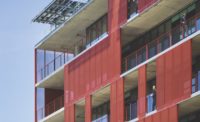One of the most labor-intensive aspects of the project has been the vetting of building products for compliance with LBC’s materials standards. These prohibit the use of 14 potentially toxic chemicals and substances on the challenge’s red list—many of which, such as PVC and formaldehyde, are commonplace in building materials. The restrictions are intended to ensure a healthy environment for occupants and spur market transformation. The hope is that the requirements will encourage manufacturers to examine their supply chains.
Joe David, a project associate at Point 32, estimates that he devoted roughly a year-and-a-half to investigating about 1,200 products. He points to several materials specified at Bullitt as proof that the LBC requirements are serving as a catalyst for change. One of the more notable examples is the wall assembly’s fluid-applied air-and-weather barrier. Although the design team considered the product an essential part of the high-performance building envelope, David’s research determined that the barrier contained phthalates—a red-listed family of chemicals often added to plastic to increase flexibility. In response to the design team’s queries, the barrier’s manufacturer, Lawrence, Kansas-based Prosoco, reformulated the product to eliminate the phthalates.
It will be some time before the Bullitt has sufficient post-occupancy data to complete its LBC documentation. But already, the building is making a mark on the design and construction industry. The response of the air-and-vapor barrier manufacturer us just one indication. And if the Bullitt’s bid for living building status proves successful, it could serve as an ecologically restorative model for an office building almost anywhere in the world, says Jason McLennan, ILFI CEO. “People won’t be able to say living buildings aren’t practical anymore.”









Post a comment to this article
Report Abusive Comment